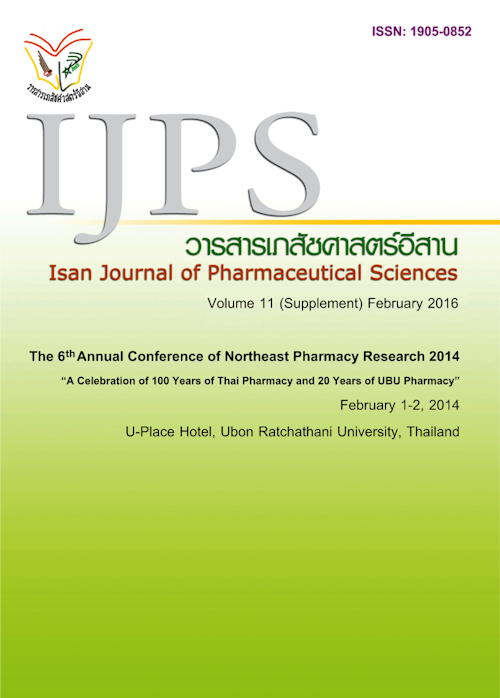The Isolation of Hydroxychavicol from P. betel L. and its Effect on DNA Fragmentation
Main Article Content
Abstract
Introduction: Piper betel is a vine widely grown in South East Asia. It was traditionally used as an ingredient for betel chewing as well as traditional herbal medicine for dermal irritation and fungal infection. Previous studies revealed that hydroxylchavicol, a major phenolic compound from P. betel leaf, possessed antioxidative, antimutagenic and anticarcinogenic activities. Therefore, this study aimed to isolate this compound and to evaluate hydroxychavicol’s effect on PUC19 plasmid DNA fragmentation. Materials and Method: Dried Piper betel L. leaves were macerated with 96% ethanol (EtOH). The EtOH extract was subsequently partitioned with n-hexane, dichloromethane (CH2Cl2) and ethyl acetate (EtOAc) respectively. The CH2Cl2 extract was further isolated on silica-columns. Fractions were collected and pooled according to TLC pattern. The fraction containing major compound was further purified on a Sephadex LH20 column. Structure elucidation of the compound was done by means of NMR and MS. Various concentrations of this isolated compound were subsequently tested for its effects on PUC19 plasmid DNA breaks. Results: By means of chromatographic techniques, a pure compound, hydroxychavicol (yield 0.008% dw), was isolated from P. betel leaf extract. Structural identification was accomplished by1H-,13C-NMR and MS. Hydroxychavicol by itself at concentrations ranging 5, 8, 16 and 32µM did not induce PUC19 DNA breaks but hydroxychavicol at concentrations of 0.5, 1, 2, and 5 mM respectively led to DNA damage. Interestingly, H2O2-induced DNA fragmentation was suppressed by hydroxychavicol at low concentration but DNA damage was markedly enhanced by hydroxychavicol at high concentration (>1mM). Conclusion: This study shows that hydroxychavicol is isolated from P. betel Land its effect on DNA fragmentation depends on the exposed concentrations. Therefore, further study should be conducted to investigate its underlying mechanisms.
Article Details
In the case that some parts are used by others The author must Confirm that obtaining permission to use some of the original authors. And must attach evidence That the permission has been included


